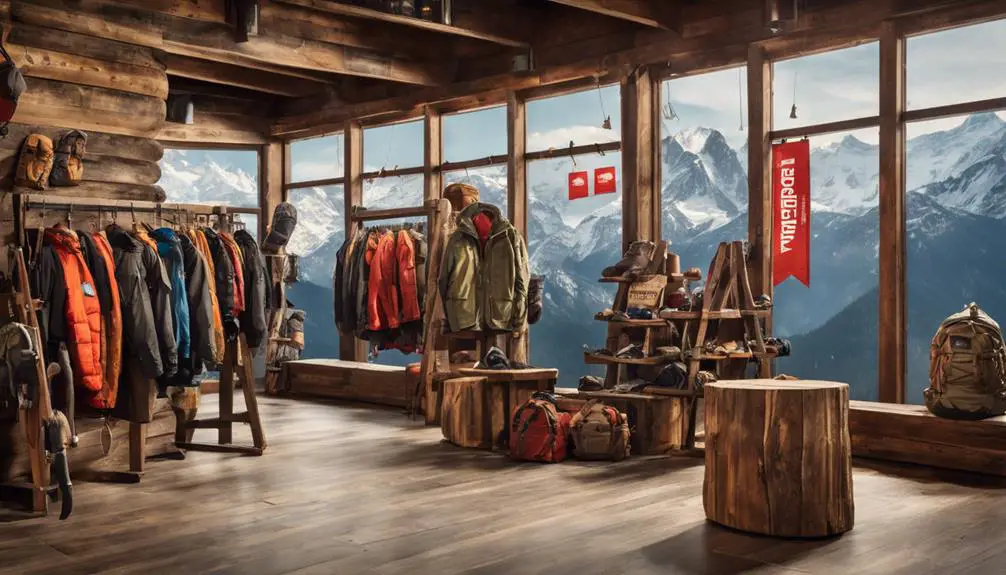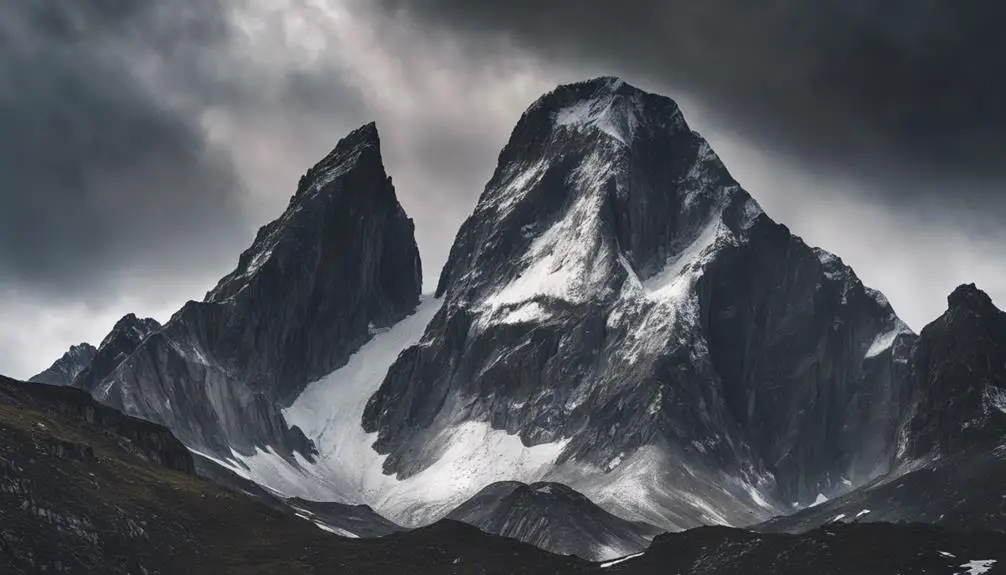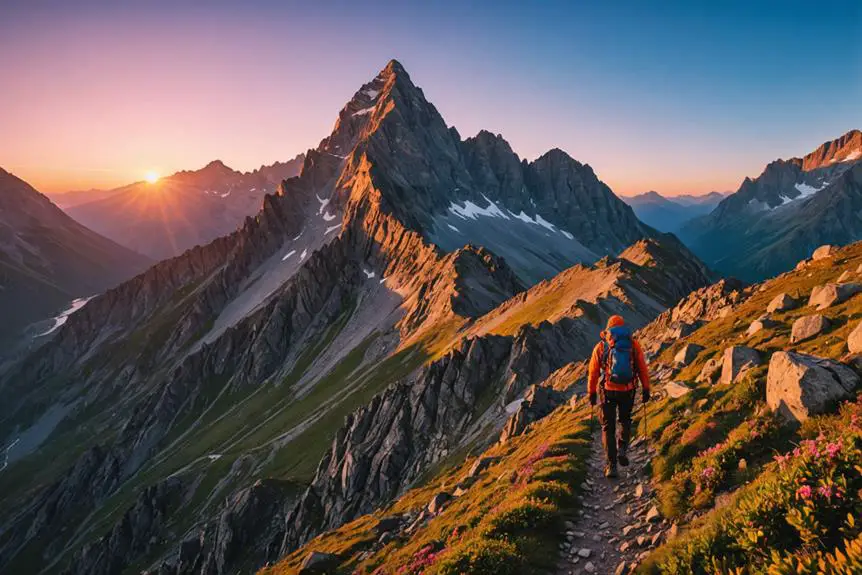The term "North Face" refers to the coldest and harshest side of a mountain, symbolizing the extreme challenges faced by climbers. Founded in 1966, the brand embodies adventure, mental toughness, and respect for nature. It represents a spirit of exploration and resilience, appealing to those who conquer obstacles in outdoor pursuits. The brand encourages a connection to the environment while providing high-quality gear designed for tough conditions. Its logo, inspired by Yosemite's Half Dome, further emphasizes these values. If you're curious about its history and influence in outdoor culture, there's plenty more to uncover.
Brand Origins and History

The North Face has a rich history that began in 1966 in San Francisco's North Beach neighborhood, where it focused on mountaineering gear and outdoor exploration. Founded by Doug Tompkins, this brand aimed to promote a new climbing culture while inspiring a love for environmental conservation.
By catering to outdoor enthusiasts, The North Face quickly gained traction among adventurers, who appreciated the high-quality gear designed for extreme conditions. Similar to Columbia Sportswear's commitment to outdoor enthusiasts, The North Face has evolved while maintaining a dedication to innovation and performance in outdoor apparel and gear, as seen in their technological advancements.
In those early years, the company became synonymous with mountaineering, pushing boundaries and encouraging people to venture into the great outdoors. The mantra "Never Stop Exploring™" emerged during this time, motivating individuals to embrace adventure and discover new horizons. This slogan encapsulated the spirit of the brand, urging you to explore beyond your limits.
As the demand for outdoor gear grew, The North Face shifted from a niche retailer to a mainstream lifestyle brand. In 2000, the company was acquired by VF Corporation, which further expanded its reach and visibility.
Despite this growth, the core values established by Tompkins remained intact. The North Face continues to honor its brand origins by prioritizing environmental conservation and supporting the climbing culture.
Today, when you wear The North Face gear, you're not just donning high-performance apparel; you're also embracing a legacy of adventure and a commitment to exploring the great outdoors. You're part of a community that values nature and the thrill of discovery, all while staying true to the brand's roots in San Francisco.
Meaning Behind the Name
Named after the coldest and iciest side of a mountain, North Face embodies the challenges climbers face in extreme conditions. This name isn't just a title; it symbolizes the brand's commitment to equipping outdoor explorers for formidable adventures.
When you think of the north face of a mountain, you probably envision harsh weather and rugged terrain. This imagery represents not only the physical demands of climbing but also the mental toughness required to tackle such challenges.
The brand has evolved from its humble beginnings in 1966 to become a cultural icon influencing fashion and lifestyle, connecting with climbers, thinkers, and musicians in the process. Doug Tompkins, the founder of The North Face, wanted to inspire a new culture of climbing and outdoor exploration. He believed that by embracing the name, the brand could foster a deeper appreciation for the environment, as seen in their notable expeditions and sustainability efforts.
The North Face encourages you to respect nature while preparing for its unpredictability. That's why the brand emphasizes conservation, reminding you that the great outdoors needs protection.
For explorers, the North Face brand is more than just gear; it's a badge of dedication to overcoming obstacles. The equipment you choose from this brand is designed to withstand the toughest conditions, ensuring you're ready to face whatever the mountain throws your way.
In essence, the meaning behind the name North Face resonates with anyone who loves adventure and challenges. As you venture out into the wild, remember that this name embodies not only a brand but also a spirit of exploration and a call to protect the environment we cherish.
Characteristics of North Faces

What makes the north face of a mountain so unique? North faces stand out primarily because they receive less sunlight. This means they're often colder, resulting in a higher likelihood of snow and ice year-round. For climbers, this presents a challenging adventure, as they'll encounter a mix of rock, snow, and ice on their routes. Each ascent requires specialized gear and thorough preparation to navigate these conditions successfully.
The steepness of north faces plays a significant role in their ruggedness. These slopes maintain their dramatic characteristics over time due to colder temperatures that support permafrost, minimizing erosion.
You'll often find that the landscape features on north faces are striking, with sheer cliffs shaped by glacial activity. The formation of glaciers contributes to both the beauty and the challenges of climbing these mountains.
Climbing north faces isn't just a physical test; it's a psychological one, too. The cold and lack of sunlight can make these climbs some of the most demanding routes. Successful ascents depend not only on skill and stamina but also on mental resilience.
The diverse and harsh conditions climbers face on these slopes create a unique environment that both tests and rewards them. Fundamentally, north faces are a blend of natural beauty and formidable challenges, making them a fascinating subject for climbers and enthusiasts alike.
Climbing Challenges and Significance
Climbing north faces presents a unique array of challenges that test both your physical and mental limits. These intimidating ascents symbolize the extreme exploration that draws outdoor enthusiasts and mountaineers alike. The North Face, known for its harsh conditions, demands specialized preparation and advanced skills. When you tackle these icy walls, you're not just facing rock and ice; you're also confronting psychological difficulties that can weigh heavily on your mind.
As you ascend, endurance becomes your best friend. Each step can feel grueling, especially when battling fierce winds and frigid temperatures. The harsh climate can drain your energy and challenge your resolve, making the climb as much a test of mental strength as physical capability.
Doug Tompkins, the founder of The North Face, recognized this struggle and aimed to equip climbers with the gear needed to take on these formidable challenges. His vision was to support adventurers in conquering tough terrains, enabling you to push beyond your limits.
The pursuit of climbing north faces isn't just about reaching the top; it represents a significant milestone in a mountaineer's journey. Each ascent is an adventure filled with risks and rewards, where every obstacle you overcome builds confidence and resilience.
Logo Symbolism and Branding

The North Face logo serves as a powerful emblem of outdoor adventure, instantly recognizable to enthusiasts worldwide. Designed by David Alcorn in 1971, this iconic logo draws inspiration from the Half Dome peak in Yosemite National Park, symbolizing outdoor exploration.
Its unique design features a slanted quarter-circle accompanied by two inner lines representing the Earth's hemispheres, reinforcing the brand's deep connection to nature.
The North Face has expertly crafted its branding to resonate with outdoor lovers. Here are some key elements of their logo symbolism:
- Color Scheme: The bold red and black colors reflect passion, courage, and dominance, enhancing brand recognition.
- Typeface: The use of Helvetica Bold gives the logo a modern and clear appearance, emphasizing quality in outdoor clothing.
- Adventure Ethos: The tagline "Never Stop Exploring," introduced in 1988, captures the spirit of adventure that defines the brand.
- Cultural Impact: The logo has become a staple in the outdoor industry, symbolizing not just a brand, but a lifestyle.
- Community Connection: When you visit a North Face store, the logo serves as an invitation to join a community of adventurers.




